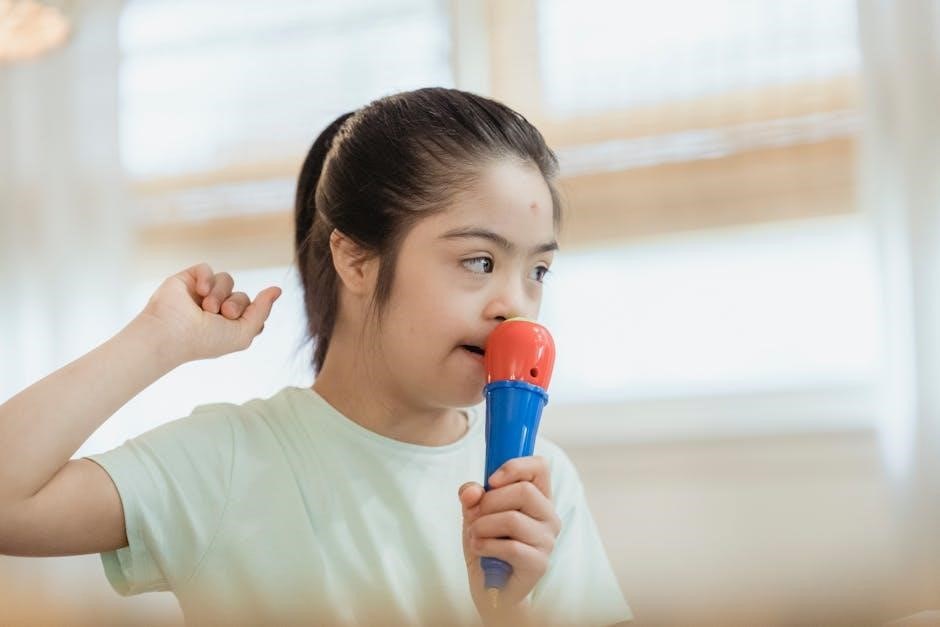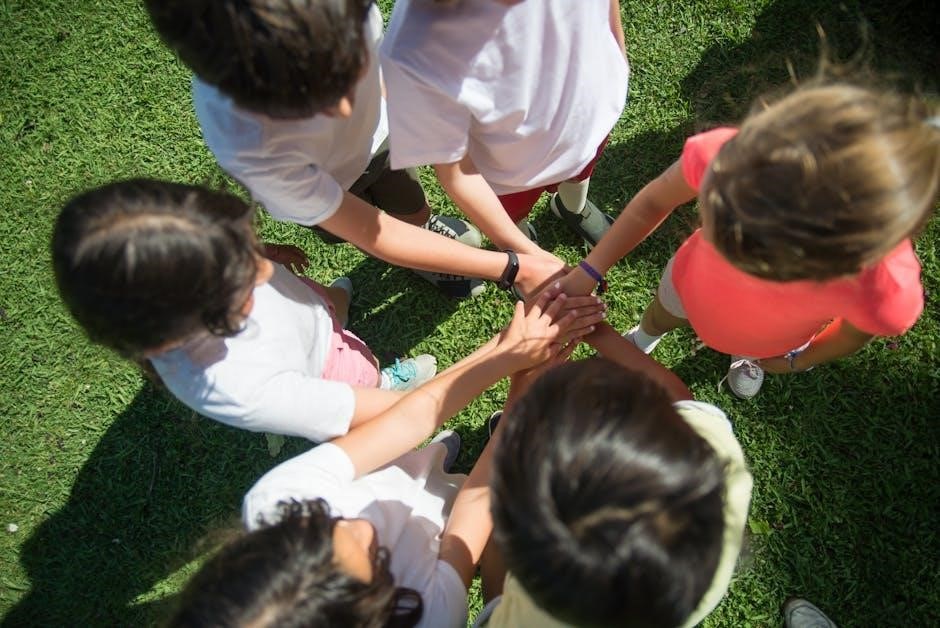blending activities pdf
Blended Learning Activities combine traditional face-to-face teaching with online strategies, utilizing interactive PDFs to enhance engagement and simplify lesson planning for educators and students alike․
Definition and Overview
Blended Learning Activities (BLA) combine traditional face-to-face classroom teaching with online educational strategies, creating a hybrid approach that enhances flexibility and engagement․ These activities integrate digital tools, such as interactive PDFs, to support diverse learning styles and objectives․ By merging online and offline components, BLA provides a balanced and adaptable learning environment, making it easier for educators to design and implement effective lesson plans while catering to the needs of modern learners․
Relevance in Modern Education
Blended Learning Activities (BLA) are highly relevant in modern education due to their ability to address diverse learning needs and preferences․ By combining digital and traditional teaching methods, BLA enhances engagement, accessibility, and efficiency․ It supports personalized learning, allowing students to work at their own pace and access resources like interactive PDFs anytime․ This approach aligns with the growing demand for flexible and technology-integrated education, making it a cornerstone of contemporary educational strategies․
Evolution of Blended Learning
Blended learning has evolved significantly over the years, transitioning from basic hybrids of traditional and online learning to sophisticated, tech-driven models․ Early adopters focused on combining classroom instruction with digital tools, while modern approaches integrate advanced platforms and interactive resources like PDFs․ This evolution reflects the growing need for flexible, student-centered education, leveraging technology to enhance accessibility, engagement, and personalized learning experiences․

Benefits of Blended Learning Activities
Blended learning enhances flexibility, personalizes experiences, and boosts engagement through diverse activities․ It caters to varied learning styles, increases accessibility, and optimizes educational efficiency effectively․

Flexibility in Learning
Blended learning offers unparalleled flexibility, allowing students to manage their time and pace effectively․ Learners can access materials anytime, from any location, and engage with content at their own speed․ This adaptability accommodates diverse schedules, enabling students to balance education with other responsibilities․ Additionally, blended learning fosters a self-directed approach, empowering students to take ownership of their learning journey and make choices that suit their individual needs and preferences․
Personalized Learning Experiences
Blended learning allows for tailored instruction, catering to individual student needs and preferences․ By leveraging technology, educators can create adaptive learning paths that align with each student’s pace, strengths, and weaknesses․ This approach fosters deeper engagement and improved outcomes, as learners receive targeted support and resources․ Personalization also encourages self-directed learning, enabling students to explore topics in-depth and develop skills at their own rhythm, enhancing overall academic success and satisfaction․
Enhanced Student Engagement
Blended learning activities significantly boost student engagement by combining interactive digital content with hands-on tasks․ Learners can participate in real-time polls, quizzes, and collaborative projects, fostering active involvement․ The integration of multimedia elements, such as videos and simulations, makes complex concepts more accessible and engaging․ This hybrid approach also encourages peer-to-peer interaction, creating a dynamic learning environment that motivates students to stay focused and invested in their educational journey, leading to improved retention and overall performance․
Popular Models of Blended Learning
Popular blended learning models include the Station Rotation, Flipped Classroom, and Project-Based Learning․ Each offers a unique approach to integrating online and offline activities effectively․
- Station Rotation combines in-person and digital learning․
- Flipped Classroom reverses traditional lecture and homework․
- Project-Based Learning emphasizes real-world applications․
Station Rotation Model
The Station Rotation Model organizes learning into structured rotations, blending online and offline activities․ Students move through different stations, with at least one involving digital content, while others focus on hands-on or collaborative tasks․ This approach allows for differentiated instruction and personalized pacing, ensuring diverse learning needs are met․ It fosters engagement and efficient time management, making it ideal for classrooms with limited technology access․ Teachers can easily monitor progress and adjust activities based on student performance․
- Combines digital and hands-on learning experiences․
- Encourages small-group collaboration and individual work․
- Supports tailored instruction for varied student needs․
Flipped Classroom Model
The Flipped Classroom Model reverses traditional teaching by assigning pre-recorded lessons for homework and using class time for interactive activities․ This approach enhances engagement and allows teachers to provide personalized support․ It accommodates diverse learning paces, fostering deeper understanding and collaboration․

- Delivers instructional content through pre-recorded videos or readings at home․
- Uses class time for interactive activities and hands-on assignments․
- Promotes flexibility and tailored instruction to meet individual needs․
Project-Based Learning Model
The Project-Based Learning Model engages students in real-world projects that integrate multiple subjects and skills․ It fosters critical thinking, collaboration, and problem-solving by allowing students to explore complex questions and challenges․ This approach encourages active learning, creativity, and application of knowledge, preparing students for practical scenarios and lifelong learning․ It aligns well with blended learning by incorporating digital tools and resources to enhance project execution and presentation․
- Focuses on real-world applications and problem-solving․
- Encourages collaboration and critical thinking․
- Integrates technology for enhanced project execution․

Designing Effective Blended Learning Activities
Designing effective blended learning activities requires intentional planning, aligning with learning goals, and integrating digital and traditional methods seamlessly to enhance engagement and outcomes for all learners․
Aligning Activities with Learning Objectives

Aligning blended learning activities with clear learning objectives ensures relevance and focus․ Educators should define measurable outcomes and design tasks that directly support these goals․ Using tools like Bloom’s Taxonomy can help create activities that promote critical thinking and application․ Assignments should be structured to bridge online and offline experiences, fostering consistency and reinforcing key concepts․ Regular assessment and feedback loops ensure activities remain purposeful and aligned with intended learning outcomes․
Integrating Online and Offline Components
Blended learning activities require seamless integration of online and offline elements․ Platforms like Learning Management Systems (LMS) and interactive PDFs enable smooth transitions between digital and physical resources․ For example, students can complete online quizzes and then engage in group discussions offline, ensuring a cohesive learning experience․ This approach maximizes flexibility while maintaining engagement, making it essential for modern educational strategies to balance both modalities effectively․
Evaluating the Effectiveness of Activities
Evaluating blended learning activities involves assessing their impact on student outcomes and engagement․ Use quizzes, discussions, and project submissions to measure understanding․ Track participation in online forums and offline workshops to ensure active involvement․ Analyze data from learning platforms to identify strengths and areas for improvement․ Regular feedback from students and educators helps refine activities, ensuring they align with learning goals and promote continuous improvement in the blended learning environment․

Challenges in Implementing Blended Learning
Blended learning faces challenges like technology access, teacher training, and student motivation, requiring strategic planning and resources to ensure successful implementation and equitable learning opportunities․
Technology and Resource Availability
Ensuring access to reliable technology and resources is a significant challenge in blended learning․ Many institutions face inequities in device availability, internet connectivity, and software subscriptions․ Additionally, outdated infrastructure and limited bandwidth can hinder online learning experiences․ Addressing these issues requires substantial investment in hardware, internet services, and digital tools․ Without equitable access, students may struggle to participate fully, creating disparities in learning outcomes and engagement within blended environments․
Teacher Training and Support
Effective blended learning requires educators to possess strong technical and pedagogical skills․ Many teachers face challenges in integrating digital tools and online platforms into their teaching practices․ Continuous professional development is essential to build confidence and competence․ Schools must provide ongoing training, mentorship, and access to resources to support educators in designing and delivering blended activities․ Without adequate support, teachers may struggle to effectively implement blended learning, impacting student outcomes and engagement in hybrid environments․
Student Motivation and Participation
Student motivation and participation are critical for the success of blended learning activities․ Educators can foster engagement by incorporating interactive elements, personalized content, and real-time feedback․ Encouraging collaboration between online and offline tasks also enhances involvement․ However, challenges such as digital distractions and inconsistent internet access can hinder participation․ To address this, clear communication and structured activities are essential to maintain student focus and motivation in blended environments․
Case Studies and Success Stories
Real-world examples demonstrate blended learning’s effectiveness, showcasing improved student outcomes and increased engagement across educational institutions and corporate training programs․
Implementation in K-12 Education
K-12 schools have successfully integrated blended learning, combining online resources and traditional teaching methods․ Interactive PDFs, such as worksheets and multimedia content, enhance engagement․ Personalized learning plans allow students to progress at their own pace, while flipped classrooms and station rotations optimize classroom time․ Teachers use online platforms to track progress and provide real-time feedback․ This approach has improved academic outcomes, increased student participation, and prepared learners for a technology-driven future․ Schools report higher test scores and better student motivation․
Blended Learning in Higher Education
Higher education institutions widely adopt blended learning to enhance flexibility and engagement․ Interactive PDFs and online platforms provide students with accessible course materials․ Faculty integrate virtual labs and forums to supplement lectures․ This model accommodates diverse learning styles, fostering deeper understanding․ Institutions report improved retention rates and student satisfaction․ Blended learning also supports research and collaboration, preparing graduates for modern workforce demands․ Its adaptability ensures continued relevance in evolving academic landscapes․
Corporate Training and Professional Development
Blended learning is revolutionizing corporate training by combining online modules with in-person sessions․ Interactive PDFs and webinars provide flexible learning options for employees․ This approach enhances skill development and knowledge retention․ Gamification elements and real-time feedback engage participants effectively․ Companies benefit from consistent training delivery and reduced costs․ Blended learning also supports ongoing professional development, ensuring employees stay competitive in a rapidly changing work environment․ Its adaptability makes it a valuable tool for modern workforce training․
Resources and Tools for Blended Learning
Essential tools include Learning Management Systems (LMS), interactive PDFs, and collaboration platforms․ These resources streamline content delivery, enhance engagement, and support personalized learning experiences for all participants․
Online Platforms and Learning Management Systems
Online platforms like Canvas, Moodle, and Google Classroom are integral to blended learning, offering tools for content delivery, progress tracking, and student interaction․ Learning Management Systems (LMS) enable educators to upload resources, including interactive PDFs, quizzes, and multimedia․ These platforms support personalized learning paths, allowing students to access materials anytime․ Integration of LMS with collaboration tools fosters engagement and real-time feedback, enhancing the overall blended learning experience for both students and educators․
Interactive PDFs for Blended Activities
Interactive PDFs are versatile tools for blended learning, combining text, images, videos, and quizzes in one document․ They allow students to engage with content dynamically, fostering active participation․ Features like clickable buttons, hyperlinks, and fillable forms enhance interactivity, making learning more immersive․ Educators can design these PDFs to align with lesson objectives, blending online and offline activities seamlessly․ This format supports self-paced learning and provides immediate feedback, making it ideal for diverse learning environments and student needs․
Best Practices for Educators
Successful blended learning requires educators to design structured, engaging activities․ Start by aligning content with clear learning objectives․ Use technology thoughtfully, ensuring accessibility for all students․ Encourage collaboration and communication between online and offline participants․ Provide regular, constructive feedback to guide student progress․ Monitor engagement and adapt strategies to meet diverse needs․ Continuous professional development helps educators refine their blended learning approaches, ensuring effective implementation and improved student outcomes over time․

Creating a Blended Learning Lesson Plan
Define clear objectives, integrate online and offline activities, and incorporate interactive resources like PDFs․ Ensure collaboration, feedback, and adaptability to meet diverse learning needs effectively․
Setting Clear Learning Outcomes
Clearly defining learning outcomes is crucial for effective blended learning․ Begin by identifying specific, measurable goals aligned with the curriculum․ Use Bloom’s Taxonomy to ensure outcomes address knowledge, comprehension, and higher-order thinking․ Break down complex objectives into manageable tasks, ensuring alignment with assessments and activities․ Communicate these outcomes to students upfront, using resources like PDF guides to outline expectations․ This clarity helps students stay focused and educators design targeted blended activities․
Designing Engaging Activities
Engaging blended learning activities require careful planning to captivate students’ interest․ Incorporate interactive elements like group discussions, hands-on tasks, and multimedia resources․ Leverage technology tools to create dynamic content, such as gamified quizzes or collaborative projects․ Ensure activities promote active participation, fostering critical thinking and creativity․ Use real-time feedback mechanisms to keep students motivated․ Align activities with learning outcomes to maintain relevance and purpose, ensuring a seamless blend of online and offline experiences․
Assessment and Feedback Strategies
Effective blended learning relies on robust assessment and feedback strategies․ Use quizzes, discussions, and projects to gauge understanding․ Technology tools enable real-time feedback, fostering improvement․ Align assessments with learning objectives to ensure clarity․ Provide constructive, specific feedback to guide students․ Encourage self-assessment and peer review to promote reflection․ Regular evaluations help track progress and refine instruction․ Transparent expectations and timely responses are crucial for student success in blended environments․

Engagement Strategies for Blended Learning

Boost engagement with interactive activities, gamification, and real-time collaboration․ Use discussion forums, polls, and virtual breakout rooms to foster participation․ Incorporate multimedia and hands-on tasks to captivate learners․ Provide immediate feedback and encourage peer interaction to enhance motivation and deepen understanding in blended environments․
Collaborative Learning Activities
Collaborative learning activities foster teamwork and interaction among students, blending online and offline tasks․ Tools like Google Docs and Padlet enable real-time collaboration, while think-pair-share and group projects encourage face-to-face engagement․ These activities promote critical thinking, communication, and problem-solving skills․ By integrating collaborative tasks, educators create a dynamic learning environment that balances technology and human interaction, ensuring students stay engaged and motivated․ Collaborative activities also enhance peer-to-peer learning and accountability, making blended learning more effective and enjoyable for all participants․
Real-Time Feedback and Assessment
Real-time feedback and assessment are critical in blended learning, enabling immediate evaluation of student progress․ Tools like polls, quizzes, and interactive simulations provide instant results, allowing educators to adjust instruction dynamically․ Learning Management Systems (LMS) facilitate automated grading and detailed performance tracking, ensuring timely interventions․ Students benefit from clear, prompt insights into their understanding, while educators gain actionable data to refine teaching strategies and improve learning outcomes effectively․
Incorporating Gamification Elements
Incorporating gamification elements enhances engagement and motivation in blended learning․ Techniques like points, badges, and leaderboards create a fun, competitive environment․ Interactive activities such as quizzes, puzzles, and challenges encourage active participation․ Gamification elements align with learning objectives, fostering a sense of achievement and progress tracking․ By integrating these elements, educators can make learning more dynamic and rewarding, ensuring students stay motivated and invested in their educational journey․
Future Trends in Blended Learning
Future trends in blended learning emphasize technology integration, personalized learning experiences, and immersive environments, creating dynamic and adaptive educational landscapes for all learners․
Role of Artificial Intelligence
Artificial intelligence (AI) is revolutionizing blended learning by personalizing experiences through adaptive assessments and real-time feedback․ AI-driven tools analyze student performance, tailoring content to individual needs․ Chatbots and virtual assistants enhance engagement, while predictive analytics identify at-risk learners early․ AI also automates administrative tasks, allowing educators to focus on teaching․ Integrating AI into blending activities ensures a more dynamic and responsive learning environment, fostering improved outcomes and efficiency in education․
Virtual and Augmented Reality Integration
Virtual (VR) and Augmented Reality (AR) are transforming blended learning by creating immersive, interactive experiences․ VR enables students to explore virtual labs or historical sites, while AR overlays digital content onto physical environments․ These technologies enhance engagement and deepen understanding of complex concepts․ Educators can integrate VR/AR activities into blending learning designs, offering students hands-on experiences that align with curriculum goals․ This integration fosters creativity, collaboration, and practical skill development, making learning more accessible and impactful for diverse learners․
Microlearning and Bite-Sized Activities
Microlearning involves delivering content in short, focused intervals, making it easier for learners to digest information․ Bite-sized activities are designed to be concise, often lasting 10-15 minutes, and are highly flexible․ This approach enhances retention, reduces overwhelm, and allows learners to fit education into busy schedules․ By breaking down complex topics into manageable chunks, educators can cater to diverse learning paces and preferences, ensuring a more effective and engaging blended learning experience․
Continuous Improvement in Blended Learning
Continuous improvement ensures blended learning remains effective and relevant․ By monitoring progress, gathering feedback, and refining strategies, educators can enhance outcomes and adapt to evolving needs․
Monitoring Student Progress
Monitoring student progress is crucial for optimizing blended learning activities․ By tracking engagement, completion rates, and performance data, educators can identify strengths and areas needing improvement․ Utilizing analytics tools within learning management systems (LMS) provides real-time insights, enabling timely interventions․ Regular assessments and feedback loops ensure personalized support, fostering better academic outcomes and continuous refinement of instructional strategies․ This iterative process helps tailor activities to meet diverse learner needs effectively․
Gathering Feedback from Stakeholders
Gathering feedback from stakeholders, including students, teachers, and administrators, is essential for refining blended learning activities․ Surveys, focus groups, and one-on-one interviews are effective methods to collect insights․ Feedback helps identify what works well and areas for improvement, ensuring activities align with learning goals․ Regular communication fosters collaboration and transparency, enabling educators to adapt strategies and enhance overall program effectiveness․ This iterative process promotes continuous improvement and stakeholder satisfaction․
Professional Development for Educators
Professional development for educators is crucial for successfully implementing blended learning activities․ Workshops, training programs, and peer-to-peer learning opportunities help teachers gain the skills needed to design and deliver effective blended lessons․ Hands-on experience with digital tools and instructional strategies ensures educators are confident in integrating technology and traditional methods․ Ongoing support and resources enable teachers to continuously improve and adapt to evolving educational demands, fostering innovation and student success․
